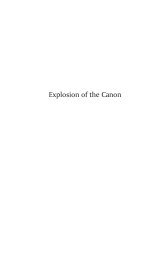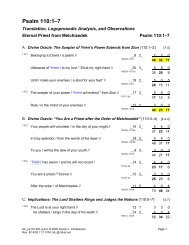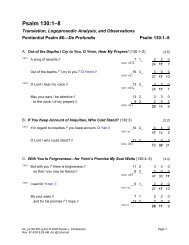Reading Genesis 1-2 in Hebrew - Bibal.Net
Reading Genesis 1-2 in Hebrew - Bibal.Net
Reading Genesis 1-2 in Hebrew - Bibal.Net
You also want an ePaper? Increase the reach of your titles
YUMPU automatically turns print PDFs into web optimized ePapers that Google loves.
<strong>Read<strong>in</strong>g</strong> <strong>Genesis</strong> 1–2 <strong>in</strong> <strong>Hebrew</strong><br />
�������������„���—transliteration: w¸-lOµ' yit-BO-HAµ-H˚, “and they were not ashamed.” The verb here<br />
is Hithpolel 3 rd pl. masc. from the hollow root Hwb (“be ashamed”), which is preceded by the<br />
particle of negation '»l (“not”).<br />
Explanatory Remarks on the Text and Translation of <strong>Genesis</strong> 1–2<br />
The large <strong>Hebrew</strong> letter p (after 1:5, 8, 13, 19, 23, 31; and 2:3) represents the traditional<br />
PeT˚xAh (open) layout markers, which are used to mark spaces <strong>in</strong> the <strong>Hebrew</strong> text of handwritten<br />
manuscripts <strong>in</strong> Jewish masoretic tradition. Such spaces must occupy the width of at least<br />
three letters. The PeT˚xAh (open) layout markers <strong>in</strong>dicate where a new “paragraph” must be<br />
written at the beg<strong>in</strong>n<strong>in</strong>g of the l<strong>in</strong>e. If enough space cannot be left on the last l<strong>in</strong>e of the old<br />
“paragraph,” a whole l<strong>in</strong>e must be left blank (as is the case after Gen 1:13 <strong>in</strong> Codex L).<br />
Maimonides describes this method of mark<strong>in</strong>g “paragraphs;” but there is difference of op<strong>in</strong>ion on<br />
the exact mean<strong>in</strong>g <strong>in</strong> the usage of the two basic layout markers: PeT˚xAh (open) and seT˚mAh<br />
(closed) layout markers. The Masorah mentions a third type of division (pisqa sedurah), but it is<br />
not known what it was or how it was marked.<br />
The Torah is divided for the Sabbath read<strong>in</strong>gs <strong>in</strong> two different ways—<strong>in</strong> 154 sections<br />
(sedarim) for a three-year [Palest<strong>in</strong>ian] cycle and 54 sections (parashot) for a one-year<br />
[Babylonian] cycle. The beg<strong>in</strong>n<strong>in</strong>g of the second sedarim at Gen 2:4 is marked by the marg<strong>in</strong>al<br />
notation ynH <strong>in</strong> the pr<strong>in</strong>ted version of the <strong>Hebrew</strong> text below. The beg<strong>in</strong>n<strong>in</strong>g of each seder <strong>in</strong><br />
<strong>Hebrew</strong> manuscripts is shown by the sign s <strong>in</strong> the marg<strong>in</strong>, often with some form of<br />
ornamentation (as <strong>in</strong> Codex L). Accord<strong>in</strong>g to Aron Dotan (<strong>in</strong> BHL), a third seder beg<strong>in</strong>s at the<br />
beg<strong>in</strong>n<strong>in</strong>g of Gen 3:20, which is marked with the notation [yHylH] <strong>in</strong> the text presented here.<br />
There is no such mark, however, <strong>in</strong> Codex L. In the Babylonian system of 54 parashot, the first<br />
parashah ends at the end of Gen 6:8.<br />
The use of different colors <strong>in</strong> the highlight<strong>in</strong>g of the <strong>Hebrew</strong> text, the transliteration, and the<br />
English translation is an attempt to call the reader’s attention to repetition of words, phrases,<br />
and the conclud<strong>in</strong>g clause for each of the six work<strong>in</strong>g days of Creation (Gen 1:5b, 8b, 13, 19, 23<br />
and 31b).<br />
Logoprosodic Analysis<br />
The five columns of numbers <strong>in</strong> the right marg<strong>in</strong> of the English translation below constitute the<br />
substance of the logoprosodic analysis of the <strong>Hebrew</strong> text. The first column of numbers<br />
represents the mora-count of that particular l<strong>in</strong>e (a mora is a subdivision of the syllable, s<strong>in</strong>ce<br />
the <strong>Hebrew</strong> language dist<strong>in</strong>guishes between short and long syllables). A short syllable is<br />
counted as one mora and a long syllable as two morae. The second column of numbers<br />
<strong>in</strong>dicates the syntactic accentual-stress (SAS) units (i.e., the number of disjunctive accent signs<br />
<strong>in</strong> that particular l<strong>in</strong>e). The last three columns <strong>in</strong>dicate the word-count: with the total count <strong>in</strong> the<br />
first column, the number of words before atnach <strong>in</strong> the second column, and the number of words<br />
after atnach <strong>in</strong> the third column. The word-count falls <strong>in</strong>to discernible patterns that highlight four<br />
primary compositional numbers: 17, 23, 26 and 32. For detailed study of this method of<br />
analysis, see the web-site www.bibal.net.<br />
© 2005 BIBAL Corporation, All Rights Reserved Version 1.0<br />
38





